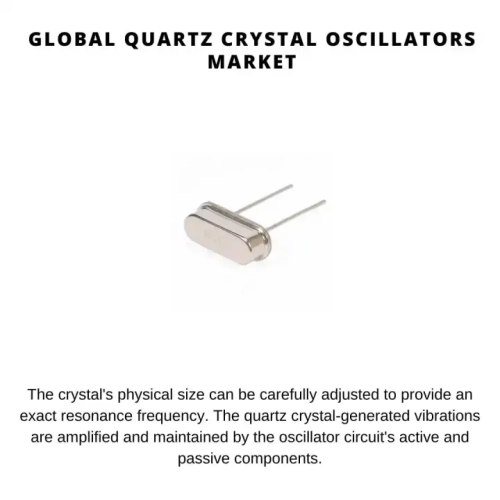
- Get in Touch with Us

Last Updated: Apr 25, 2025 | Study Period:
Quartz oscillators, also referred to as quartz crystal oscillators, are basic electronic components utilized in a variety of applications for producing accurate and reliable electrical signals.

They function by using the quartz crystals' piezoelectric capabilities, which enables them to deliver precise time references required by various electronic systems. A quartz crystal resonator, a tiny fragment of quartz crystal that has been specifically cut and polished, sits at the center of a quartz crystal oscillator.
The crystal displays the piezoelectric effect under an electric field, deforming and producing electrical charges in response to mechanical pressure. This characteristic causes the crystal to vibrate at its resonance frequency, which is a certain frequency.
The crystal's physical size can be carefully adjusted to provide an exact resonance frequency.The quartz crystal-generated vibrations are amplified and maintained by the oscillator circuit's active and passive components.
These elements give the crystal the essential feedback loop to keep its vibrations at its resonance frequency. Quartz oscillators are preferable to other oscillator types, such as RC oscillators, since the generated electrical signal is exceptionally stable and predictable over time.
Quartz crystal oscillators are essential in many applications, including telecommunications, consumer electronics, aerospace, and scientific instruments, due to their exceptional frequency stability.
They act as microprocessor clock references to provide precise data processing and synchronization. They are also utilized for precise signal creation and frequency synthesis in radio transmitters and receivers.

The Global quartz crystal oscillators market accounted for $XX Billion in 2023 and is anticipated to reach $XX Billion by 2030, registering a CAGR of XX% from 2024 to 2030.
CA, Carlsbad To accommodate the constantly expanding market for applications requiring timing devices in the automobile industry, QVS Tech Inc. has launched the QCA series of crystals that complies with AEC-Q200 automobile specifications.
With operational temperature ranges as wide as -40°C to +125°C and frequency stabilities of 20ppm, the QCA crystal product families are offered in a variety of package sizes, including a 1.6mm x 1.2mm x 0.4mm. A
dvanced driving assistance systems (ADAS), traction and stability control modules, Ethernet, entertainment, and navigation are examples of automotive applications that call for timing devices. Applications call for tight stability, a wide temperature range, compact designs, and resistance to extreme conditions.
The European Chips Act allocated over â¬43 billion ($45.8 Billion) in public and private investments can double Europe's global semiconductor market share from 10% to 20% by 2030.
Major semiconductor companies like Bosch, Intel, and TSMC have announced new investments and projects in Europe to increase their global market presence which will boost the overall market
The U.S. CHIPS and Science Act's $5 billion investment aims to drive innovation and bolster America's competitiveness in the vital semiconductor industry.
Global semiconductor manufacturing equipment sales contracted 6.1% in 2023 from a record $107.4 billion in 2022. It is expected to see growth in 2024 but not to the 2022 levels.
| Sl no | Topic |
| 1 | Market Segmentation |
| 2 | Scope of the report |
| 3 | Abbreviations |
| 4 | Research Methodology |
| 5 | Executive Summary |
| 6 | Introduction |
| 7 | Insights from Industry stakeholders |
| 8 | Cost breakdown of Product by sub-components and average profit margin |
| 9 | Disruptive innovation in the Industry |
| 10 | Technology trends in the Industry |
| 11 | Consumer trends in the industry |
| 12 | Recent Production Milestones |
| 13 | Component Manufacturing in US, EU and China |
| 14 | COVID-19 impact on overall market |
| 15 | COVID-19 impact on Production of components |
| 16 | COVID-19 impact on Point of sale |
| 17 | Market Segmentation, Dynamics and Forecast by Geography, 2024-2030 |
| 18 | Market Segmentation, Dynamics and Forecast by Product Type, 2024-2030 |
| 19 | Market Segmentation, Dynamics and Forecast by Application, 2024-2030 |
| 20 | Market Segmentation, Dynamics and Forecast by End use, 2024-2030 |
| 21 | Product installation rate by OEM, 2023 |
| 22 | Incline/Decline in Average B-2-B selling price in past 5 years |
| 23 | Competition from substitute products |
| 24 | Gross margin and average profitability of suppliers |
| 25 | New product development in past 12 months |
| 26 | M&A in past 12 months |
| 27 | Growth strategy of leading players |
| 28 | Market share of vendors, 2023 |
| 29 | Company Profiles |
| 30 | Unmet needs and opportunity for new suppliers |
| 31 | Conclusion |
| 32 | Appendix |